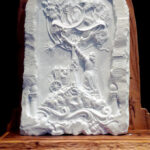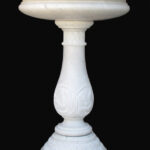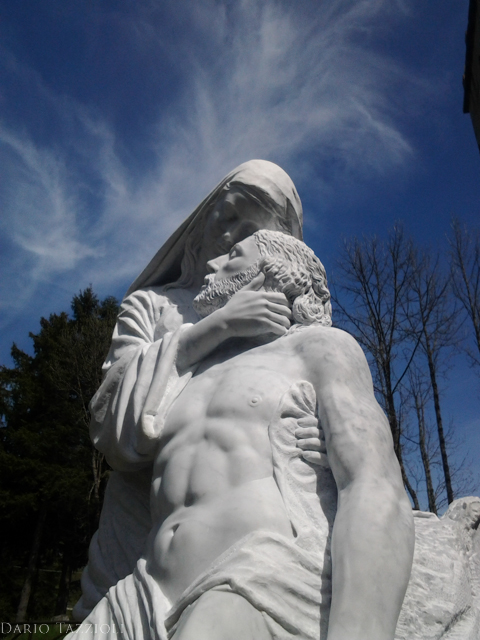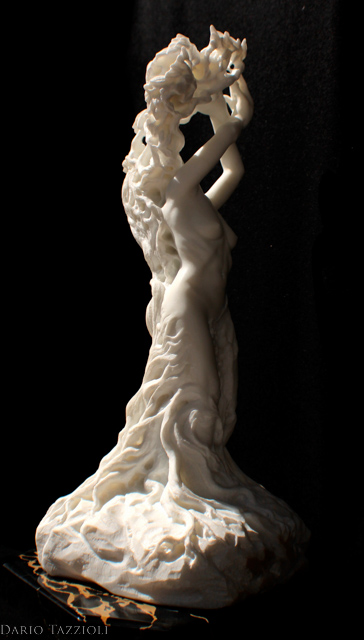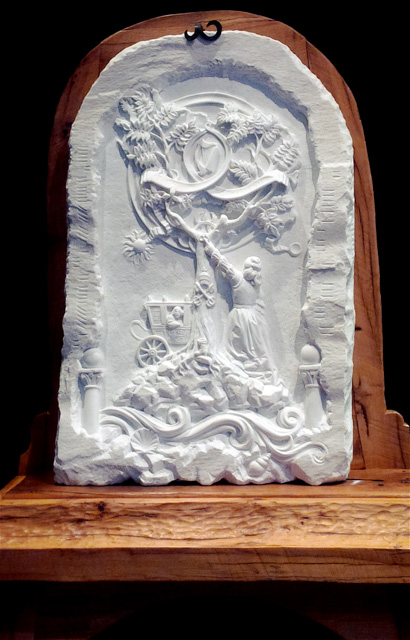The full relief sculpture “Pietà” is a commission from the City Hall of Frassinoro, province of Modena on the Appennines mountains in the North of Italy. It is installed outside in front of the medieval church of the village.
The name Frassinoro means “Golden Ash” and during the Middle Age there was an important benedectine abbey, decorated with beautiful marbles and stones. The abbey unfortunately was destroyed, but some of it still last today: the traditional Via Crucis (Way of the Cross), performed every three years on Good Friday (www.viacrucisvivente.com).
This Via Crucis is kind of unique because there are 15 still life “stations” around the village where people from Frassinoro play motionless the characters of the Passion. They stay still for over one hour each station in front of many visitors from all Italy and Europe.
The Way of The Cross
Dario Tazzioli already carved some years ago 15 high-reliefs, one for each station, in local sandstone. In this way the Via Crucis is visible every day of the year trough the interpretation of the sculptures.
About one year ago the City Hall also decided to have a monument, a symbol for this particular Via Crucis, so they entrusted Dario to create a sculpture on the subject of the Pietà.
Dario crated a clay model first and then he chose directly the block of marble at the quarry in Carrara, Toscany, the same place where Michelangelo chose his marbles.
The sculpture is over 8 feet high and originally it was 8 tons heavy. The marble was chosen with particular care for its strength and hardness, because the Pietà has to stay outside in the long and cold winters of Frassinoro, over 3000 feet above sea level.
The sculpture is carved with traditional steel tools that Dario forges by himself as artist did during the Renaissance. The sculpture is carved with traditional steel tools that Dario forges by himself as artist did during the Renaissance.
Even if Jesus is dead (it is the moment just after the Deposition from the Cross), he looks almost asleep, meaning his victory on the death. Virgin Mary holds his head tenderly, suggesting the relationship between the Mother and the Son.
Italian video interview
The name Frassinoro means “Golden Ash” and during the Middle Age there was an important benedectine abbey, decorated with beautiful marbles and stones. The abbey unfortunately was destroyed, but some of it still last today: the traditional Via Crucis (Way of the Cross), performed every three years on Good Friday (www.viacrucisvivente.com).
This Via Crucis is kind of unique because there are 15 still life “stations” around the village where people from Frassinoro play motionless the characters of the Passion. They stay still for over one hour each station in front of many visitors from all Italy and Europe.
The Way of The Cross
Dario Tazzioli already carved some years ago 15 high-reliefs, one for each station, in local sandstone. In this way the Via Crucis is visible every day of the year trough the interpretation of the sculptures.
About one year ago the City Hall also decided to have a monument, a symbol for this particular Via Crucis, so they entrusted Dario to create a sculpture on the subject of the Pietà.
Dario crated a clay model first and then he chose directly the block of marble at the quarry in Carrara, Toscany, the same place where Michelangelo chose his marbles.
The sculpture is over 8 feet high and originally it was 8 tons heavy. The marble was chosen with particular care for its strength and hardness, because the Pietà has to stay outside in the long and cold winters of Frassinoro, over 3000 feet above sea level.
The sculpture is carved with traditional steel tools that Dario forges by himself as artist did during the Renaissance. The sculpture is carved with traditional steel tools that Dario forges by himself as artist did during the Renaissance.
Even if Jesus is dead (it is the moment just after the Deposition from the Cross), he looks almost asleep, meaning his victory on the death. Virgin Mary holds his head tenderly, suggesting the relationship between the Mother and the Son.
Italian video interview

